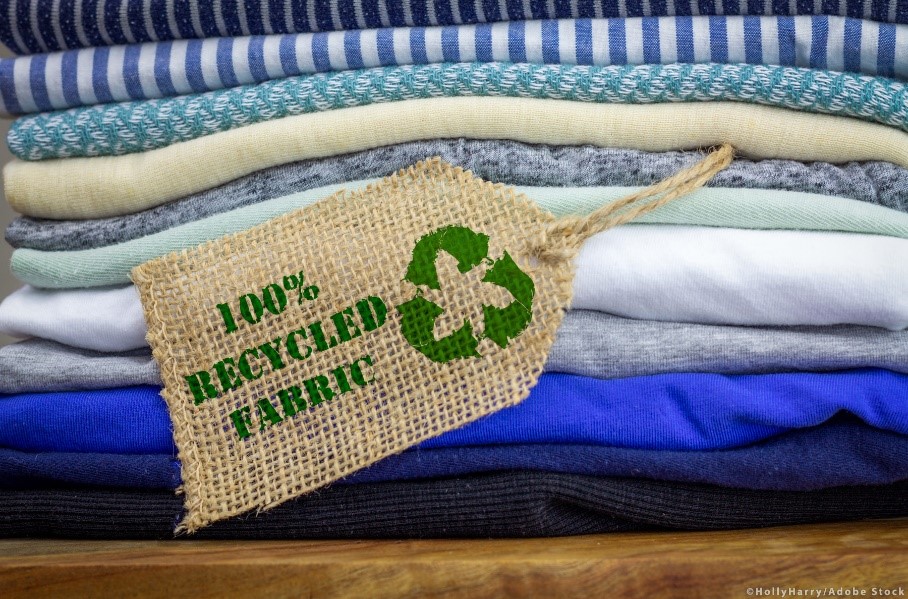The global textile industry has long been synonymous with fast fashion, mass production, and laying a massive amounts of waste. With the growing awareness of climate change, the concept of circularity has emerged as a new impactful factor. Circular fashion represents a shift towards a regenerative system that aims to minimize waste, conserve resources, and create a more sustainable common future for all. The concurrent concerns pose the textile industry to embrace circularity, and exploit its potentials.
A closed-loop system within the textiles where resources could be used more efficiently, waste is minimized, products are designed for reuse, and recycling or composting at the end of products’ life cycle – we call it Circularity in Textiles. Circularity aims to move away from the traditional linear model of “Take-Make-Dispose” towards a more sustainable and environment conducive way.
Principles of Circularity in textiles:
- Durability and longevity in design- Products are designed to be durable and long-lasting, using high-quality materials and construction techniques. It facilitates extending the product’s life cycle and reducing the call for frequent replacements.
- Recycling and upcycling- Recycling involves converting textile waste or discarded products into new fibers or materials, which can then be used as raw materials to make new products. Upcycling, on the other hand, involves transforming waste materials into higher-value products without downgrading their quality components.
- Closed-loop production systems- Circular textile systems aim to minimize waste and pollution by implementing closed-loop production systems. It helps reducing water and energy consumption, implementing efficient production processes, and recycling or reusing manufacturing wastes.
- Consumer awareness and engagement- Circularity requires an active participation and cooperation of consumers. Educating consumers about the importance of sustainable choices, proper product care, and responsible disposal is essential for achieving circularity in textiles.
Sustainable materials usages- Circular textiles prioritize the use of sustainable and renewable materials, such as organic cotton, hemp, linen, and recycled fibers. Such materials contain a lower environmental impacts.
Source- European Commission
- Putting manufacturers responsible- It promotes the idea of extended producer’s responsibility by taking circularity for the entire life cycle of their products. It includes designing for recyclability or composability, providing take-back programs for used products, and ensuring proper disposal or recycling of products at the end of their usage.
Enable better use of lands and resources:
By adopting practices such as recycling, upcycling, and waste reduction, the demand for raw materials and virgin resources can be significantly reduced. This helps conserve natural resources such as water, energy, and minerals, which are often extracted from the earth.
- Reduced landfill waste- The textile industry generates a large amount of waste, with a significant portion ending up in landfills. Circular systems aim to minimize this waste by promoting recycling and reusing textile materials. By diverting textiles from landfills and extending their life cycle through recycling or upcycling, circularity reduces landfills and prevents environmental pollution associated with textile waste.
- Land and space optimization- Adopting circular practices can help optimize land and space utilization within the textile industry. Implementing closed-loop production systems and recycling facilities on-site can minimize transportation distances and reduce the need for large storage or landfill areas.
- Sustainable agriculture- By supporting sustainable agriculture, circularity contributes to better land management, soil health, and biodiversity conservation. Fibers can be cultivated using environment friendly agricultural practices that minimize soil erosion, water pollution, and the use of harmful chemicals.
- Reduced environmental impact- By reducing resource consumption, waste generation, and pollution, circularity helps protect ecosystems, reduce greenhouse gas emissions, and mitigate climate change. This contributes to better resource management by preserving natural habitats, reducing water and air pollution, and minimizing ecological disruptions.
Adapting Circularity can be profitable as well:
Circularity practices can help businesses optimize the use of resources such as raw materials, energy, and water. By reducing waste and maximizing resource efficiency, companies can lower their production costs and operational expenses. For example, using recycled fibers or materials can be more cost-effective than sourcing virgin materials.
Source- European Parliament
Enhanced product life cycles and customer loyalty- Circular textile products are designed to be durable and long-lasting. This can lead to increased customer satisfaction and loyalty. By focusing on quality and longevity, businesses can establish a reputation for producing reliable and sustainable products, leading to repeat purchases and positive word-of-mouth referrals.
- Value creation from waste materials – Circular textile businesses can find opportunities to extract value from waste materials. Recycling or upcycling textile waste can result in the creation of new products or materials with market value. By turning waste into a resource, companies can generate additional revenue streams.
- Consumer demand for sustainability- Consumers are increasingly concerned about the environmental impact of the products they purchase. By positioning themselves as environmentally conscious and offering circular products, companies can attract a growing customer base and potentially charge a premium for sustainable products.
- Access to new markets – Circular textile businesses can tap into emerging markets, as circularity gains traction in the textile industry, this can open up new avenues for business growth, market expansion, and innovative collaborations.
- Regulatory incentives and support – Governments and regulatory bodies in the USA and EU countries are increasingly promoting sustainable practices and offering incentives for businesses that adopt circular approaches. This can include tax incentives, grants, or subsidies for implementing circular processes, recycling initiatives, or using sustainable materials.
- Brand differentiation and reputation – Embracing circularity in textiles allows businesses to differentiate themselves from competitors. By highlighting their commitment to sustainability and circular practices, companies can build a brand image and gain a competitive edge in the market.
While an initial investment, and operational adjustments required to transition to circularity, the long run benefits can outweigh the costs and contribute to the profitability of businesses. As sustainability becomes more mainstream, incorporating circular practices can position companies as leaders in the industry and help them thrive in the evolving market landscape.
– The writer is an Innovation Strategist.
